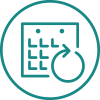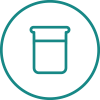
Serum Chemistry

Serum Chemistry
Purpose:
The Serum Chemistry programme is available as part of a comprehensive suite of programmes to assess and monitor the performance of the routine Clinical Biochemistry laboratory’s repertoire of core tests used for the diagnosis and monitoring of disease.
The interference of bilirubin in a number of spectrophotometric methods such as kinetic alkaline picrate creatinine assays (Jaffe) for creatinine assays is well known and for this reason, a separate programme is provided for bilirubin to ensure that a true assessment of method performance and bias can be provided in the Serum Chemistry Programme for those analytes affected by icteric interference.
Separate samples, distributed twice a year are provided to assess the effects of interferences i.e Haemolysis, Icterus and Lipaemia on the Serum Chemistry analytes and methods.
Serum Indices is also available as a separate programme to assess the performance of the HIL indices assays.
Scope:
Four liquid human serum samples are distributed monthly, with a minimum of 48 samples distributed over the year covering a wide clinically relevant range. The samples consist of a panel of 8 linearly related samples distributed on a number of occasions over that period which are used to assess both laboratory and method performance, including linearity, bias, within and between batch imprecision. Trueness is also assessed for a number of analytes using high metrological order Reference measurement systems.
Additional challenging samples are distributed to assess diagnostic accuracy near the cut points, method interferences and for educational purposes.
Calculated parameters are also assessed such as:
Adjusted Calcium, e-GFR, Calculated Globulins, TIBC and Transferrin Saturation.
Reference target values are provided for Na, K, Li, Mg, Ca, AST, LDH, GGT, ALT, Creatinine, Glucose and UA.
 |
Key Features:
|
| Serum Chemistry Programme | ||
|---|---|---|
| Analyte | Approx. Range Covered | |
| Sodium | 100 - 165 | mmol/L |
| Potassium | 1.6 - 8.0 | mmol/L |
| Chloride | 73 - 123 | mmol/L |
| Bicarbonate | 7 - 28 | mmol/L |
| Urea | 1.5 - 25 | mmol/L |
| Creatinine | 25 - 600 | µmol/L |
| e-GFR | <15 - >90 | mLs/min/1.73m2 |
| Glucose | 1.4 - 25 | mmol/L |
| Calcium | 1.2 - 3.3 | mmol/L |
| Adjusted Calcium | 1.4 - 3.0 | mmol/L |
| Phosphate | 0.2 - 2.2 | mmol/L |
| Total Protein | 34 - 86 | g/L |
| Albumin | 20 - 53 | g/L |
| Calculated Globulin | 20 - 40 | g/L |
| Magnesium | 0.2 - 2.0 | mmol/L |
| Urate | 100 - 700 | µmol/L |
| Lithium | 0.05 - 2.0 | mmol/L |
| Lipase | 10 - 400 | IU/L |
| Osmolality | 190 - 390 | mOsmo/kg |
| AST | 5 - 300 | IU/L IFCC |
| ALT | 5 - 500 | IU/L IFCC |
| ALP | 25 - 400 | IU/L SCE |
| CK | 20 - 1200 | IU/L SCE |
| Gamma GT | 10 - 400 | IU/L SCE |
| Total Amylase | 15 - 800 | IU/L |
| Pancreatic Amylase | 20 - 160 | IU/L |
| LDH | 50 - 700 | IU/L SCE |
| Iron | 7 - 30 | µmol/L |
| TIBC | 28 - 82 | µmol/L |
| Transferrin | 1.5 - 3.5 | g/L |
| Transferrin Saturation | 22 - 30 | % |
| Gentamicin | 1 - 8 | µg/mL |
Related Documents
Last updated: 24/04/2024








